5 Seemingly Unhealthy Foods for Babies that are Actually OK
- How one of the largest choking risk foods can be easily modified and made safe for your baby
- Which seasonings are ok for early eaters…and which spices to steer clear of for babies
- What to look for on a nutrition facts panel to decide whether you offer a food to your baby or not
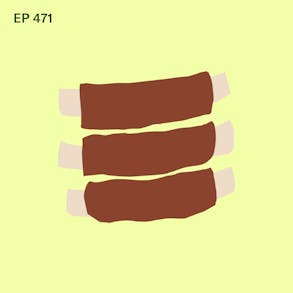
LISTEN TO THIS EPISODE
Episode Description
Some foods sound unhealthy for babies and as a good parent you think, “When in doubt…leave it out.” In this episode we’re looking at 5 seemingly unhealthy foods for babies that are actually safe or ok for your baby to eat.

Other Episodes Related to this Topic
- Episode 467 - 5 Seemingly Healthy Baby Foods to Avoid
- Episode 351 - Label Reading 101: What to Look for in Foods You Offer Your Baby
- Episode 111 - Grocery Shopping for BLW: Stocking Up Smart & What to Skip
Links from Episode
- Baby-Led Weaning with Katie Ferraro program with the 100 First Foods™ Daily Meal Plan, join here: https://babyledweaning.co/program
- Baby-Led Weaning for Beginners free online workshop with 100 First Foods™ list to all attendees, register here: https://babyledweaning.co/baby-led-weaning-for-beginners

Latest Episodes
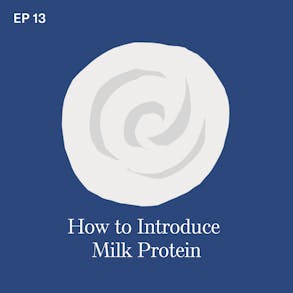
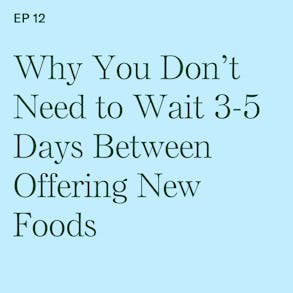
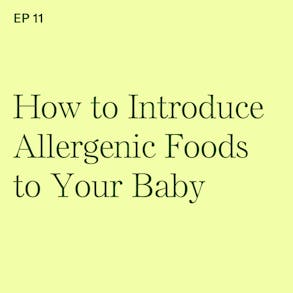
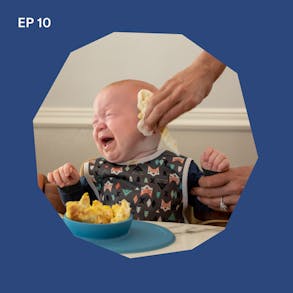
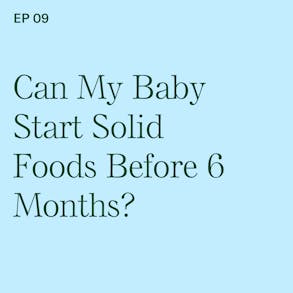
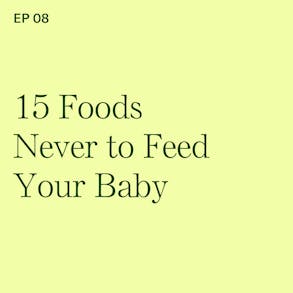
Katie Ferraro (0s):
Something that I did not anticipate that I would not love as a parent of school age kids is making my kids' school lunches. Okay. I'm so grateful that they're back in school. We're back into a routine, but by the time I get all their breakfast prepared and then all the school lunches made, I have absolutely no time or bandwidth to think about what I am going to eat.
Factor (18s):
Now as a dietitian, I know how important nutrition is and that's why I love Factors. No prep, no mess Meals Factor is my go-to Workday Lunch solution, they have a full menu of chef crafted meals with options like calorie Smart Protein Plus and keto factors fresh. Never frozen meals are dietitian approved. They're ready to eat in just two minutes. So no matter how busy you are, you'll always have time to enjoy nutritious great tasting meals. If you are looking for a way to minimize your time in the kitchen, a factor meals are ready in two minutes. No shopping, no prepping, no cooking, no cleanup. Head to factor meals.com/weaning50 and use the code WEANING50, that's five zero to get 50% off your first box plus 20% off your next month. That's code WEANING50 at factormeals.com/weaning50 to get 50% off your first box plus 20% off your next month while your subscription is active.
To Kill A Mockingbird (Broadway Show) (1m 17s):
If you are in the market for a new high chair, I just got a Mockingbird High chair and I absolutely love it. Now you might know Mockingbird from their famous single to double stroller, and usually when a stroller brand launches a highchair, not to be rude, but sometimes it is not that awesome. That is not the case with Mockingbird. They totally knocked it outta the park on this high chair. So in order to support a safe swallow, I only use highchair with adjustable Footrests and the Mockingbird Highchair. Their footrest has four heights to choose from, and that's better than a lot of brands that say they have an adjustable footrest. And it only goes to two like very random heights if you use a tray. The Mockingbird High Chair also comes standard with the tray, so you don't have to buy it separately like you do with a lot of other brands. And the tray has three depth positions to grow with your baby too. The tray liner pops off and you can throw it in the top rack of your dishwasher for easy cleaning. Now because of the Mockingbird Highchairs unique design, you can also use it safely without the tray, and I love that you can just pull your baby right up to the table to participate in mealtimes and baby led weaning. Probably my favorite feature though are these beautiful soft silicone straps that are so easy to clean, and then they have this genius like low profile hook system behind the chair to hold the straps back when you're also cleaning. Basically, this high chair has it all and it's really reasonably priced for a very beautiful and safe modern highchair. Mockingbird is offering a very nice deal for our listeners right now. When you purchase the Mockingbird Highchair, you will get their early eaters dish ware set, which also includes a cup spoons, it has a suction bowl and a lid and a silicone bib. That whole set is free. That's a $45 value when you buy the highchair and use the code BABYLED at checkout. So just head to hello mockingbird.com, put the Mockingbird Highchair and their Early Eaters dish ware set into your cart. Enter the code, BABYLED and the dish ware will be free. Again, that code is BABYLED, LED at hellomockingbird.com. And definitely check out the Mockingbird highchair.
Katie Ferraro (3m 15s):
And when it comes to those types of animal protein foods, for sure, we do not offer soft, solid pieces of meat like pork chops or steak to early eaters. Huge choking hazard. But that doesn't mean that all cuts of beef or pork are off the table, right? For example, I love beef chuck roast and beef brisket, or if you make country style beef ribs the right way, those make nice soft shreddable strips of meat. And I always say, if you can shred the meat between your fingers and your thumb, then it's perfectly safe for your baby to eat with their gums. Hey there, I'm Katie Ferraro, registered dietitian, college nutrition professor and mom of seven specializing in baby-led weaning here on the Baby-Led Weaning with Katie Ferraro Podcast.
Katie Ferraro (3m 55s):
I help you strip out all of the noise and nonsense about feeding, giving you the confidence and knowledge you need to give your baby a safe start to solid foods using baby-led weaning. Well, hello and welcome back. Today we're gonna be talking about five seemingly unhealthy foods for babies that are actually okay. And I was thinking about this topic 'cause I recently did an episode about the opposite. Back in 467, we covered Five Seemingly Healthy Baby Foods to Avoid. And as a dietitian, I don't love listing foods that babies can't eat. I prefer to think of all of the foods that babies can eat.
Katie Ferraro (4m 37s):
So in that episode, I covered some of the foods that we avoid and why, and then provided some alternatives. But in this one, it got me to thinking about foods that people just tend to think, oh, that's totally not safe for a baby to have. But if you modify it slightly, it can be absolutely safe for your baby to eat. So that's what we're covering today in this episode, about five seemingly unhealthy foods for babies that are actually okay. I like to start each of these mini training episodes with a baby-led weaning tip of the day. And today's tip is the word healthy, even though I use it in the title, it was kind of clickbait, was because the word healthy. It's not a legally enforceable or recognized term as far as food packaging goes.
Katie Ferraro (5m 18s):
The word healthy is subjective, right? It can be interpreted in a lot of ways. What you consider to be quote unquote healthy might not align with another person's dietary needs or their preferences. So some people would view foods that are high in natural fats like avocados, for example, to be unhealthy because they might, for whatever reason, be on a low fat diet. Okay? Although that hopefully kind of went outta fashion in the 1990s. But you get the idea, right? There are foods that contain beneficial nutrients that other people might say, well, those nutrients don't align with what I need right now, et cetera. So healthy is most often used as a marketing term, meaning that companies can use it to promote their products, okay? And they do not have to meet any specific legal standards. So the FDA has, that's the Food and Drug Administration in the United States.
Katie Ferraro (6m 1s):
They do have guidance on how, you know the term healthy can be used in labeling, but these are guidelines. They are not strict laws and companies are pretty much free to use the term healthy as long as it does not mislead consumers about the overall nutritional profile of the food. So I want you to hang tight. 'cause in this episode I wanna share five unhealthy foods so that you will hear touted in the medias, oh, those are unhealthy, or those are not good that are actually okay for babies. And I'll share which one or which variation of that is okay, which ones you wanna avoid, and then a resource where you can find out more about each of them. So let's go ahead and get started. And I wanna start with one of my least favorite foods on the planet, which is peanut butter.
Katie Ferraro (6m 42s):
Personally, I just don't like it. I don't like the way it smells. I don't like how sticky it is every Thursday, which my kids have half day on Friday. So I have to make lunches Monday, Tuesday, Wednesday, Thursday for them to go to school. And I make peanut butter and jelly once a week and it's on Thursday and they know it and they freaking love it and I hate it. I won't even put it in my like reusable silicone bags. I use those stacher bags for lunch because the peanut butter is so hard to clean, and I'm just like, I freaking hate peanut butter. So sorry about the peanut butter diatribe, but when it comes to peanut butter, parents are like, but well, yeah, it's a total choking hazard. And I remember watching one of my cousins give her baby a peanut butter sandwich when I was in college and was in my nutrition throughout my lifecycle class, and I was like, abhorred. I was like, did she just get that baby peanut butter?
Katie Ferraro (7m 23s):
And I learned in lifecycle nutrition that peanut butter is a choking hazard. But now that I am a dietitian and have had my own kids and teach baby-led weaning, I know that peanut butter is not a choking hazard if it's prepared properly. So yes, we want to avoid thick globs of nut butter, like peanut butter straight out of the jar. That is not a good idea for an early eater, right? Because it's so sticky that it could easily become lodge on the roof or the sides of your baby's mouth and pose a choking hazard because they don't have the mouth muscles and the muscular strength yet to be able to dislodge that from the roof of the sides of their mouth. But peanut is really important, right? Peanut protein, that's one of the top nine allergenic foods, those nine foods that account for about 90% of food allergy.
Katie Ferraro (8m 8s):
So thinned out peanut butter. If you take peanut butter and you mix it with breast milk or a formula, or I'll do unsweetened apple sauce sometimes, or yogurt, if the baby's already had cow's milk protein without an allergic reaction, you just don't do two new allergenic foods at the same time, right? So if the baby's never had milk and they've never had peanut, I don't thin out peanut butter with cow's milk. 'cause if they had a reaction, how would I know if it was from the cow's milk or the peanut? So back to the peanut butter, if you thin it out so that it's thin enough to slide off of your adult stainless steel spoon, that is an indicator that it's thin enough for your baby to be able to move around their mouth. So a thinned out peanut butter product is perfectly fine, but you also can get peanut protein into your baby with peanut flour. So I make these peanut flour pancakes, which are super easy, or if you want a low mess, no stress way to do peanut.
Katie Ferraro (8m 50s):
I love baby peanut puffs. So you've maybe seen these peanut puffs. They're not like the little star starchy puffs. They kind of look like Cheetos and they have peanut protein in them. I like the ones from the brand Puff Works baby. So Puff Works baby makes a baby peanut puff. It's no added sugar. There's just a smidge of salt in there that's for preservative, and it's the softest puff on the market. So your baby, these puffs dissolve like right in your baby's mouth and you don't even need teeth to start them.
Puffworks (9m 16s):
So if you wanna check out the Puff Works, baby peanut butter puffs, the affiliate discount code BABYLED, LED, I think that works for 15% off at puffworks.com. They also make a baby almond puff and you can get a case of half almond and half peanut if you wanna check 'em out. Both of those, the almond one just heads up, that's how I introduce tree nut. The almond puff works. Baby puff also contains peanut. So you wanna make sure you do the peanut one, which is only peanut on its own a number of times without reaction, and then do the almond one later separately a couple days later or a day later as a way to introduce them to almond, which is tree nut. You can knock two of the top nine allergenic foods out with one case of puff. So again, that code is BABYLED for 15% off at puffworks.com.
Katie Ferraro (9m 57s):
The second seemingly unhealthy food parents ask about all the time are herbs and spices like, oh, babies need to eat bland food, or I wanted to give my baby this, but it had too much seasoning on it. But okay, herbs and spices are perfectly fine for your baby. Let's start with what do we wanna avoid? We do wanna avoid any super spicy herbs or spices that could be potentially injurious to your baby, but everything else is totally above board, right? Your baby's actually already been exposed to lots of these flavor compounds, right? If you were eating, let's say a spiced food that you had cumin and your taco meat when you were pregnant, some of those flavor compounds transfer via your amniotic fluid. And let's say you had some cardamom in in Afghan stew that you were eating. When you're breastfeeding again, those compounds will transmit via your breast milk.
Katie Ferraro (10m 40s):
So your baby's already been exposed to some of these. And if there are seasoning, spices, herbs that you use in your family or cultural cooking, go ahead and do it for your baby. We just avoid any added sugar added salt. And then of course, anything that's super spicy. If you wanna learn more about how to flavor season and spice your baby's food, back in Episode 48, I interviewed Kanchan Koya. She is the author of the book Spice Spice Baby, with lots of great ideas about seasoning and spicing your baby's food safely. Again, that's in Episode 48, but don't be shy about offering your baby seasoned food and babies do not need to eat bland food. Hey, we're gonna take a quick break, but I'll be right back.
Katie Ferraro (11m 55s):
The next seemingly unhealthy food is all of this hullabaloo online about like babies can't eat grains or babies can't eat starches. I teach an online workshop called Baby-Led Weaning For Beginners, and at the end there's a q and a session and parents submit questions via question box. And I can't tell you how often parents ask about like, well, oh, I heard babies can't digest grains. If you have 20 foods on your 100 First Foods list, Katie, that are starchy foods, and I do, and most of those are whole grains, how's the baby gonna digest those? You would actually be surprised to know that your baby has the anatomy two digest foods like grains as early as three months of age, okay? That's at the point when their digestive system gets to the point where it could potentially handle the compounds in those foods.
Katie Ferraro (12m 38s):
Now, of course, we don't feed three month olds starchy or grain foods because they're not safe to swallow anything except infant milk. That's breast milk or formula. We wait until after the six month mark when they're sitting relatively on their own and they're showing us they have the head and the neck control and the trunk strength to support a safe swallow. And then it's perfectly fine for babies to start learning how to eat those starchy orders, those grain foods. Now, I would recommend that you avoid refined white bread foods, okay? Because refined grains where all the nutrition has been removed. So the kernel, which is the middle of the grain, which is where the nice fat and the B vitamins and the iron is, if you take that out on processing and you take the brand, that protective outer layer where all the fiber is, okay? When you make white refined bread products, you remove the brand and you remove the germ and you're just left with the endosperm, which is just like the pure starch, okay?
Katie Ferraro (13m 24s):
That's not ideal for babies 'cause we've removed all of the good nutrition, but if you offer the whole grain food prepared safely for the baby, okay? Any of those 20 grain foods and even more, there's lots more whole grain foods out there. I just have 20 of them in the starchy foods list on my 100 First Foods list. They're perfectly safe if they are properly prepared. So if you wanna grab a copy of that 100 First Foods list, it's on that free online workshop that I teach called Baby-Led Weaning For Beginners. Everybody on that workshop gets a copy of my original 100 First Foods list, so you'll never run out of foods including grain foods that are totally safe for your baby to eat. You can sign up for that workshop at babyledweaning.co/workshop, and I would really encourage you to get in the habit of offering your baby a variety of carbohydrate containing grain or whole grain, if possible, starchy foods, because the last thing you wanna do is get stuck in that pasta, potatoes, and rice rut.
Katie Ferraro (14m 16s):
And we see that so much with parents of toddlers. They know that children need carbohydrates to fuel their body, but they don't know how to offer anything except refined white grains like pasta or rice and potatoes, you know, in moderation are fine, but they're primarily starch, okay? And so we wanna be offering a greater variety of texture and taste and nutrition and the whole grains. They have a ton of iron in them too. Not to mention some plant protein. You can start those around the six month mark when your baby's got that all important flavor window open, or when they will like or accept a wide variety of foods, even the wacky whole grains from the 100 First Foods list. Alright? The fourth food that's seemingly unhealthy, I hear a lot of misinformation about cow's milk.
Katie Ferraro (14m 57s):
Parents will say, oh, I'm thinking about joining your program, but I wanna go dairy free. Okay? If your baby has a diagnosed cow's milk protein allergy, then yes, you do need to avoid dairy foods. And while that is more common than some of the other allergenic foods, it is still not common for infants to be allergic to cow's milk protein. And so we see a lot of misinformation, parents saying things like, oh, I think my baby is dairy intolerant, and there's no such thing as being intolerant to dairy. Back in Episode 286, I interviewed one of the world's leaders in this area, Marion Groetch. Marian talked about is my baby dairy intolerant? And she talked about this condition called food protein induced allergic practic colitis. I'm talking to the parents who very early on in your breastfeeding journey, if your baby had blood or mucus in their stool and you started removing a whole bunch of dairy from your diet and you're nervous that your baby is quote unquote allergic to cow's milk protein, you might unnecessarily be withholding those cow's milk protein foods when there's absolutely no reason that your older baby, who's now six months of age or older needs to be.
Katie Ferraro (15m 57s):
So if that was you, if you're like, oh my God, I'm freaking out about dairy because back in the day I couldn't eat dairy when I was breastfeeding. Go listen to Episode 286 with Marion. Other times parents will say things like, well, we tried some yogurt or we tried some low sodium cheeses and the baby's face broke out in a rash. There's lots of reasons why babies get atopic dermatitis or contact rashes on their face. And it very, very infrequently is a side effect of being quote unquote allergic to a food. And we covered this back in Episode 274. I interviewed another global leader in pediatric food allergies, Carina Venter. She's a PhD dietitian, and that episode is, baby has skin reactions to milk, egg, and peanut. What should I do next? Okay, we talked about what the true signs of allergic reaction are, but more often than not, what parents are describing is not a true food allergy.
Katie Ferraro (16m 43s):
Okay? And so while food allergies when they are real and diagnosed are very serious, what we end up with are lots of parents whose babies do not have cow's milk, protein allergy, and they're unnecessarily withholding all of these dairy foods. Now, it certainly is true that we want to avoid fluid cow's milk in place of infant milk, so in place of breast milk or formula prior to age one, okay? Breast milk or formula is sufficient to meet your baby's needs for the first six months of life. Then you start adding complimentary foods, but you're continuing that infant milk, okay? It's only at or after the one year mark where from a nutritional standpoint, a baby will be fine if you discontinued the infant milk and started on cow's milk. Now, lots of you who are breastfeeding may wish to continue breastfeeding beyond age one and into age two, and that's fantastic.
Katie Ferraro (17m 26s):
If you're formula feeding at age one, you'd like to stop that and start offering the baby whole milk, cow's milk. And we don't do any reduced fat non-fat or low fat dairy products for children under the age of two. Okay? That's because they need the fat from that full fat dairy for their still developing brain. But it's perfectly fine to use cow's milk protein as an ingredient in or as a supplemental food to the infant milk that your baby is getting. And we want to introduce your baby to cow's milk protein 'cause it's one of those top nine allergenic foods, okay? That's one of the nine foods that account for about 90% of food allergy. We wanna do it early and often. Alright? So after dairy, the Fifth Seemingly Unhealthy Food, I hear a lot of parents say, oh, well, I'd love for my baby to eat meat, but it's not safe for babies to eat red meat.
Katie Ferraro (18m 7s):
And I'm not sure why red meat gets singled out, but it is true. We want to avoid solid pieces of meat like steak, for example. Okay? your baby cannot easily chew steak. Just steak can be a choking hazard even for older toddlers. But that doesn't mean all beef is off the table or other red meats. As I always say, if you can shred the meat between your fingers and your thumb, then it's safe for your baby to eat with their gums. Okay? So steak, I don't care how good your steak is, you're not shredding it between your fingers and your thumb. But if you take another cut of beef, let's say beef chuck roast, or I love beef, or I love country style beef ribs or beef brisket, if you cook those properly for your baby, you get these nice soft shreddable strips of meat, which are perfectly safe for your baby to eat.
Katie Ferraro (18m 51s):
And it's not just beef, other types of meat like lamb and pork and chicken, we can make safe for early eaters to eat. And if you'd like instructions and videos on how to make all of the foods on the 100 First Foods list safe for your baby to eat, but particularly those meats 'cause that's the one that gives parents a lot of problems. I have 100 First Foods content library with all the videos and the instructions and the recipes for different ages and stages that's inside of My program. Baby-Led Weaning with Katie Ferraro can sign up for that at babyledweaning.co/program. I also have my full 100 First Foods Daily Meal Plan in there. So if you're like don, don't wanna pick out the food that they're gonna eat today. I did it for you. Five new foods a week, 20 weeks of new foods your baby's going to eat a hundred foods, all with the recipes and the instructions on how to make them, and they get progressively more challenging as your baby gets progressively better at eating.
Katie Ferraro (19m 41s):
Again, the program is called Baby-Led Weaning with Katie Ferraro, and you can sign up at babyledweaning.co. So don't forget pieces of steak that are uns, shreddable, or solid pieces of meat that you can't s shred like pork chops, for example. That's not safe for your early eater to eat, but soft shreddable strips of meat, perfectly fine for your baby to eat. All right, let's run 'em down again. Foods that a lot of people think are unhealthy or unsafe for babies that are actually totally fine if you make 'em the right way. Number one, peanut butter. Number two, spices and herbs. Number three, starchy or whole grain foods. Number four, at cow's milk foods, and number five, red meat. I will put a link to all of the resources that I mentioned in today's episode on the show notes, which you can find at blwpodcast.com/471.
Katie Ferraro (20m 23s):
A special thank you to our partners at AirWave Media. If you like podcasts that feature food and science and use in your brain, check out some of the podcasts from AirWave or online blwpodcast.com. Thank you so much for listening, and I'll see you next time. Bye now
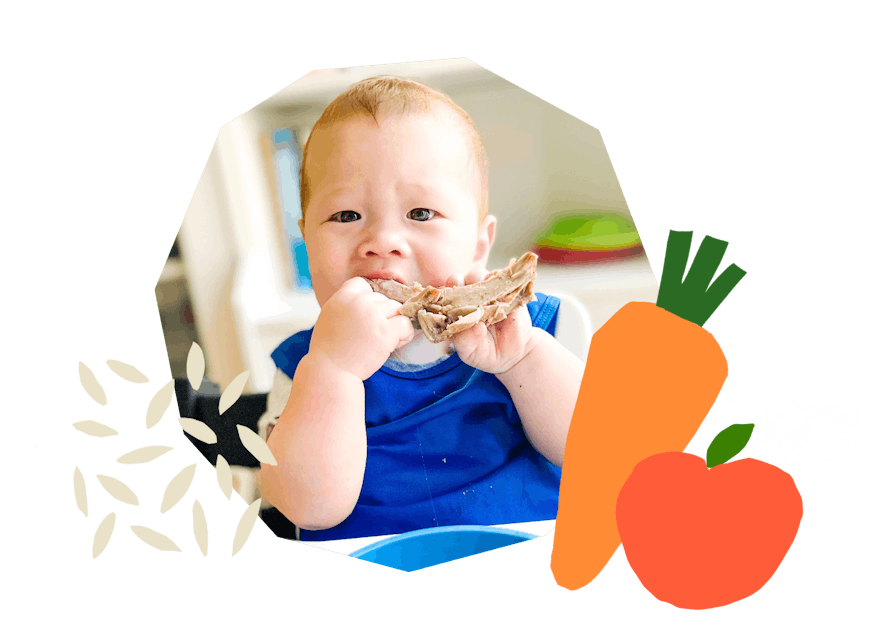
The Program Baby-Led Weaning with Katie Ferraro
A step-by-step digital program for starting solid foods safely and navigating the original 100 FIRST FOODS™ meal plan with baby-led weaning.
 EXPERT-LED, PROVEN APPROACH TO EATING REAL FOOD
EXPERT-LED, PROVEN APPROACH TO EATING REAL FOOD CONCISE VIDEO TRAININGS TO MASTER BABY-LED WEANING
CONCISE VIDEO TRAININGS TO MASTER BABY-LED WEANING 100 FIRST FOODS DAILY MEAL PLAN WITH FOOD PREP VIDEOS
100 FIRST FOODS DAILY MEAL PLAN WITH FOOD PREP VIDEOS
Baby-Led Weaning for Beginners Free Workshop
Is your baby ready to start solid foods, but you’re not sure what to do? Register for this free online video workshop and learn how to give your baby a safe start to solid foods using baby-led weaning. Everyone on this free training receives a copy of Katie’s original 100 FIRST FOODS™ list. You can take this workshop right now, later today when your baby naps, or tomorrow…whatever works for you!
Get baby-led weaning recipes and tips delivered to your email inbox.